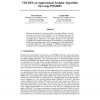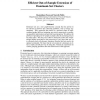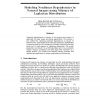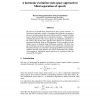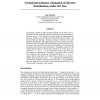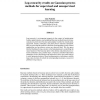112
click to vote
NIPS
2004
15 years 2 months ago
2004
We present a discriminative part-based approach for the recognition of object classes from unsegmented cluttered scenes. Objects are modeled as flexible constellations of parts co...
91
Voted
NIPS
2004
15 years 2 months ago
2004
We propose a new set of criteria for learning algorithms in multi-agent systems, one that is more stringent and (we argue) better justified than previous proposed criteria. Our cr...
106
Voted
NIPS
2004
15 years 2 months ago
2004
Existing algorithms for discrete partially observable Markov decision processes can at best solve problems of a few thousand states due to two important sources of intractability:...
103
click to vote
NIPS
2004
15 years 2 months ago
2004
We introduce a novel active-learning scenario in which a user wants to work with a learning algorithm to identify useful anomalies. These are distinguished from the traditional st...
NIPS
2004
15 years 2 months ago
2004
Dominant sets are a new graph-theoretic concept that has proven to be relevant in pairwise data clustering problems, such as image segmentation. They generalize the notion of a ma...
NIPS
2004
15 years 2 months ago
2004
Online mechanism design (OMD) addresses the problem of sequential decision making in a stochastic environment with multiple self-interested agents. The goal in OMD is to make valu...
135
Voted
NIPS
2004
15 years 2 months ago
2004
Capturing dependencies in images in an unsupervised manner is important for many image processing applications. We propose a new method for capturing nonlinear dependencies in ima...
103
click to vote
NIPS
2004
15 years 2 months ago
2004
We discuss an identification framework for noisy speech mixtures. A block-based generative model is formulated that explicitly incorporates the time-varying harmonic plus noise (H...
105
click to vote
NIPS
2004
15 years 2 months ago
2004
We develop a family of upper and lower bounds on the worst-case expected KL loss for estimating a discrete distribution on a finite number m of points, given N i.i.d. samples. Our...
110
Voted
NIPS
2004
15 years 2 months ago
2004
Log-concavity is an important property in the context of optimization, Laplace approximation, and sampling; Bayesian methods based on Gaussian process priors have become quite pop...

